In the enchanting realm of bridal fashion, tradition and elegance unite in a harmonious dance. But there is one element that stands out, like a timeless beacon of grace and heritage—the illustrious Pashmina shawl. Picture this: nestled in the heart of the breathtaking Kashmir Valley, a treasured tradition unfolds, one that has touched the lives of countless brides. It's a tradition that has passed down through generations. Hence it's a testament to love, warmth, and a token of good fortune.
Kashmiri mothers, with hearts brimming with love and blessings, have long bestowed upon their daughters a gift of immeasurable value. It was indeed the handwoven Pashmina shawl. This cherished practice has been an age-old custom and a ritual of profound significance. Mothers gifted Pashmina shawls to their daughters as they prepared to embark on the beautiful journey of matrimony. These exquisite shawls, more than just a piece of clothing, have encapsulated the spirit of familial love, protection, and blessings.
So, let's delve into the fascinating world of bridal fashion. We will try to uncover the rich tapestry of this age-old tradition, exploring the historical roots of Pashmina in Kashmir and the enduring importance it holds in the hearts of brides. We will also unravel the intricate details of Pashmina production and the artistry behind these shawls. Here we will try to find out the remarkable versatility they bring to a bride's ensemble. Pashmina, with its luxurious embrace, not only provides warmth on a special day but also symbolizes a connection to tradition. We will thus know about Pashmina's role in transforming brides into ethereal beauties, as well as its history, culture, and craftsmanship woven into the fabric of bridal fashion.
Historical Significance of Pashmina
Pashmina, often referred to as "soft gold," is an art form with an enchanting history. Its fame has transcended both time and borders. Its story traces back to the high Himalayan regions, particularly in the Kashmir Valley, where its origins have deep roots. To understand the historical significance of Pashmina in bridal fashion, we must embark on a journey through time, back to the very beginnings of this luxurious fabric.
The word "Pashmina" finds its roots in the Persian word "pashm," which means wool. The tradition of weaving Pashmina shawls dates back over five centuries. In fact, historians believe that it was the Mughal emperors who played a pivotal role in elevating the status of Pashmina to one of luxury and grandeur. These rulers recognized the extraordinary softness, warmth, and sheer beauty of Pashmina. And thus, its journey from the mountains of Kashmir to the grand courts of India began.
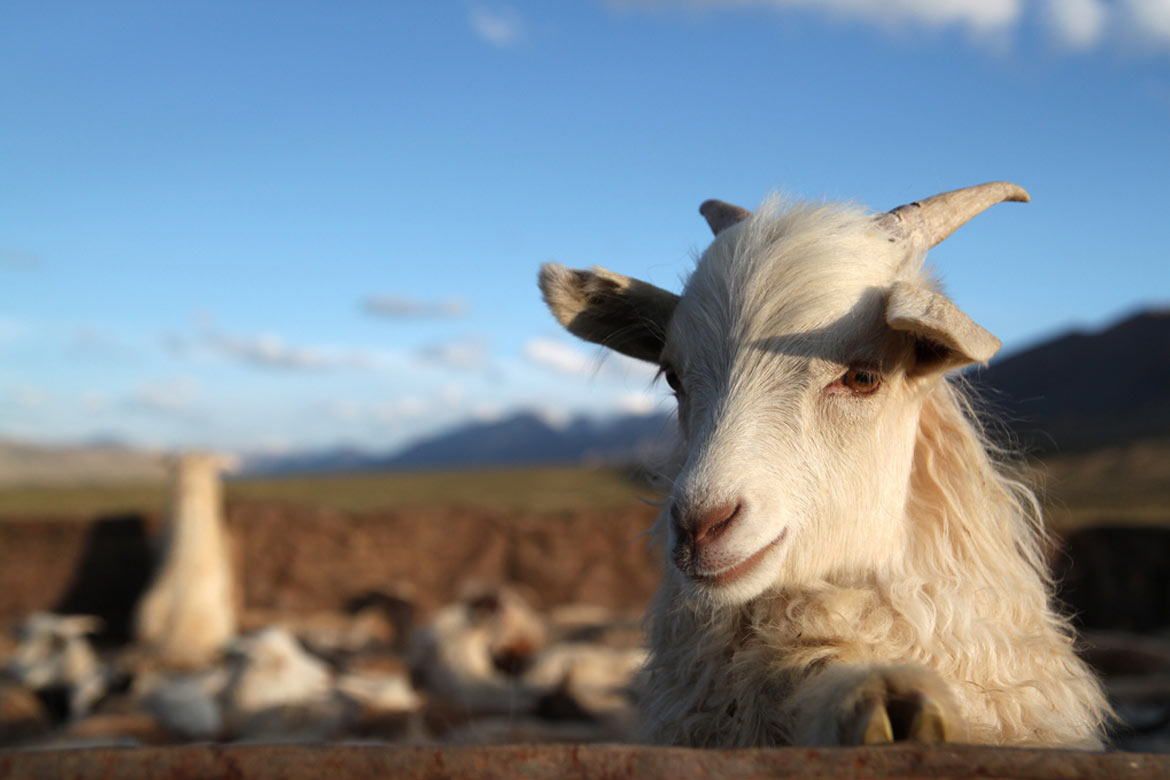
Pashmina is the art of converting fine Cashmere wool to luxury shawls, scarves, apparel and accessories. Cashmere wool comes from the underbelly of the Capra Hircus goat, also known as the Changthangi goat. The goat which thrives in the extreme cold of the Himalayas. Skilled artisans painstakingly gather, clean, and spin the fine, delicate fibres of this wool. This meticulous process results in products so soft that they're often likened to the delicate touch of a lover's hand.
Europe, Kashmir and around the World
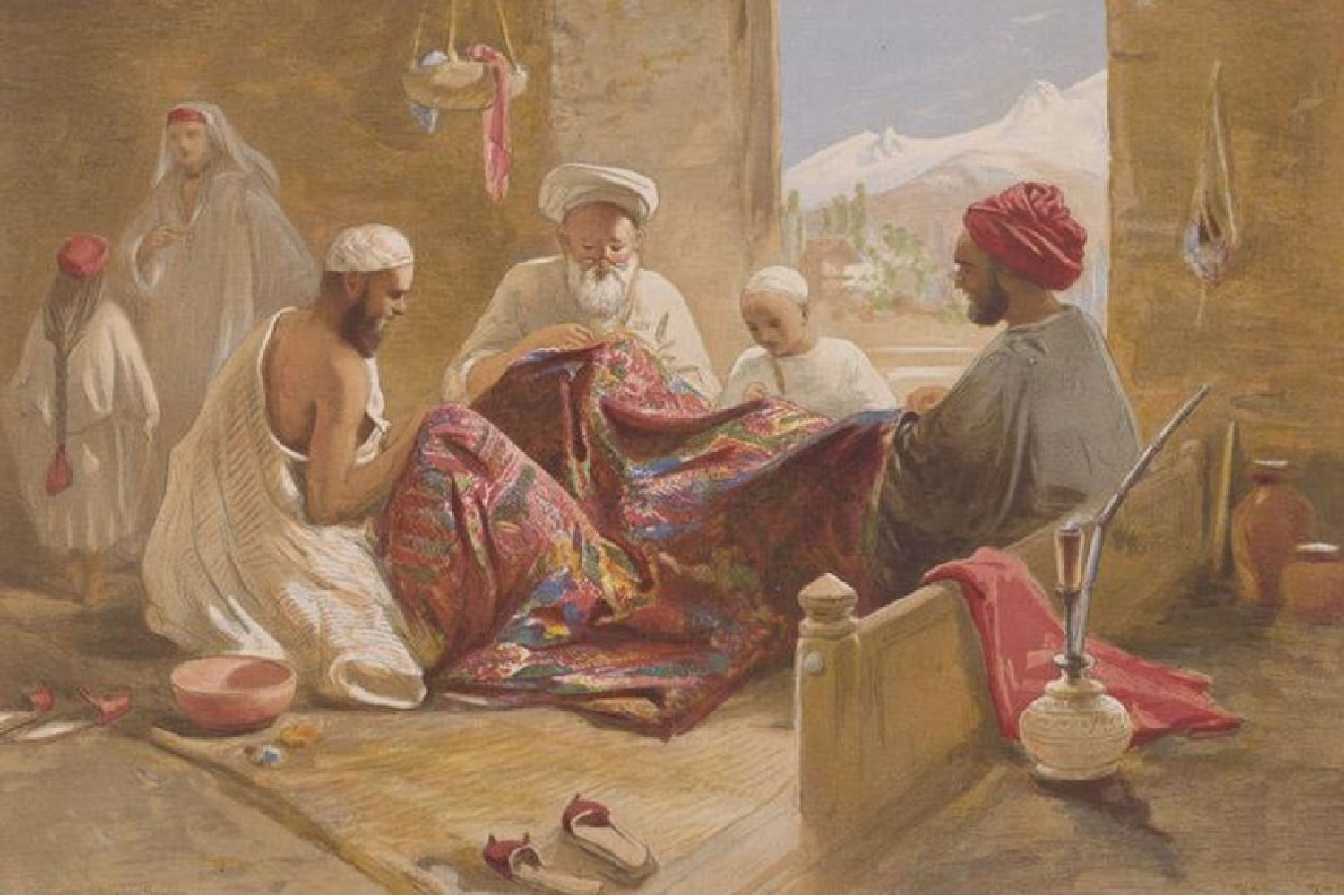
Throughout history, Pashmina shawls have been highly coveted and cherished, a symbol of luxury and elegance. They were not just garments; they were status symbols. The Mughal emperors and Persian aristocracy adorned themselves with these exquisite shawls and considered them a mark of social standing. As Pashmina made its way to the royal courts of Europe, it became the preferred choice of European nobility, further cementing its reputation as a textile of unparalleled opulence.
The historical significance of Pashmina extends beyond its use as a luxurious accessory. In Kashmiri culture, it is a symbol of affection, protection, and good fortune. For generations, Kashmiri mothers have passed down Pashmina shawls to their daughters upon their weddings, imbuing these gifts with blessings and love. Their ancestors believed that the warmth and softness of Pashmina would bring comfort and happiness to the bride in her new journey.
The allure of Pashmina has endured for centuries, enchanting both royalty and commoners alike. Its softness and elegance have transcended borders, making it a cherished and revered fabric worldwide. In the realm of bridal fashion, this rich history and tradition are interwoven into every Pashmina shawl. This makes it not just a piece of clothing, but a symbol of timeless beauty and enduring love.
Types of Bridal Pashmina
Pashmina, often associated with luxury and elegance, comes in various types, each with its unique characteristics that cater to different preferences and styles. When it comes to bridal fashion, the choice of Pashmina can be as important as the wedding dress itself, as it adds a touch of sophistication and personality to the ensemble. Let's explore the different types of Pashmina and understand why brides often prefer some over others
Kani Pashmina
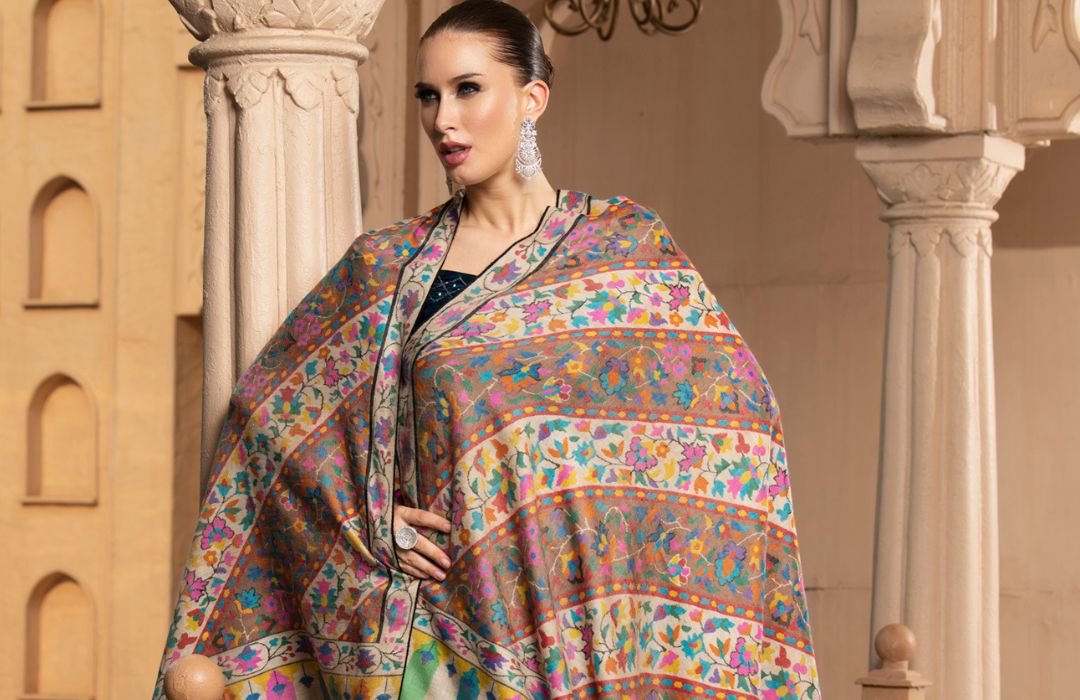
Kani Pashmina is the epitome of exquisite craftsmanship. It is characterized by intricate patterns woven directly into the fabric using a traditional wooden loom, called the "Kani." These patterns often depict intricate motifs, such as florals, paisleys, and geometric designs. Kani shawls are trendy for their artistic and cultural significance. Brides opt for Kani Pashmina to add a touch of tradition and intricate artistry to their wedding attire. The meticulously woven patterns not only provide a unique aesthetic but also tell a story of the artisan's skill and heritage.
Embroidered Pashmina
Embroidered Pashmina shawls feature delicate and ornate hand embroidery. This embellishment can range from simple threadwork to more elaborate designs with brighter colours or thick threads. Brides often choose embroidered Pashmina to add a touch of opulence and personalized style to their bridal outfits. The embroidery can complement the wedding theme or be customized to include the couple's initials or meaningful motifs. This definitely makes it a sentimental addition to the ensemble. Here are a few embroideries artisans do on wedding shawls:
Sozni Embroidery
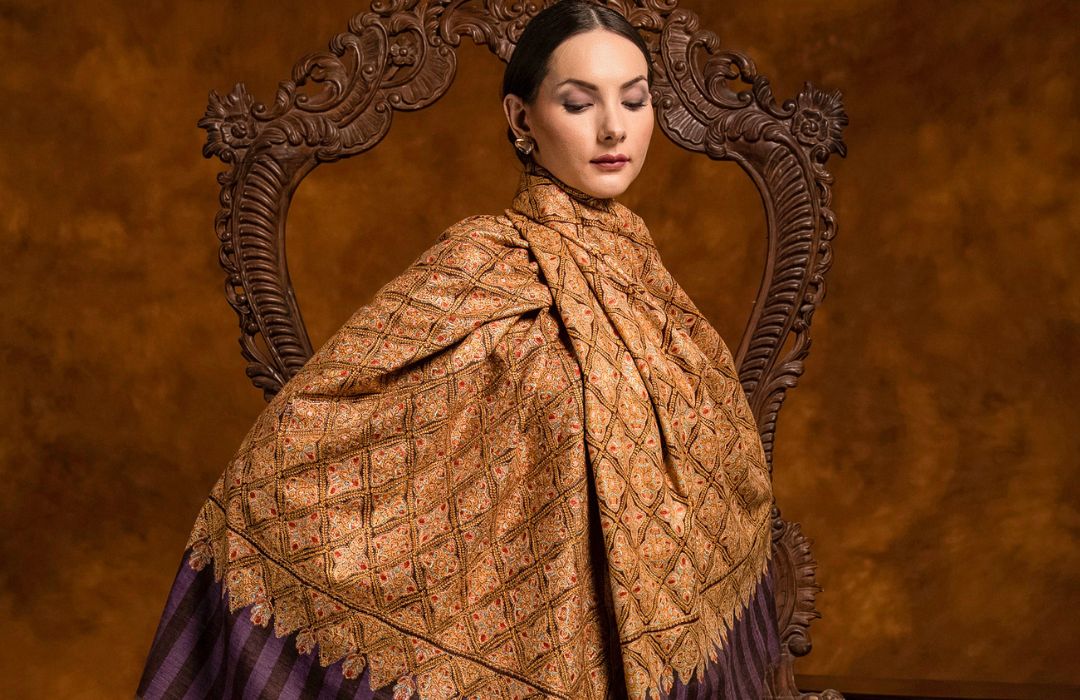
Sozni embroidery is a fine and delicate form of hand embroidery. Kashmiri artisans have perfected it over centuries. The word "Sozni" itself means "needle" in Persian, and it aptly describes the craftsmanship that goes into creating these exquisite patterns. Sozni embroidery typically involves the use of fine silk threads, which artisans meticulously stitch onto the Cashmere fabric. The result is a beautifully intricate pattern that can range from traditional motifs like florals, paisleys, chinar leaves, and geometric designs to more contemporary and personalized patterns.
Tilla Embroidery
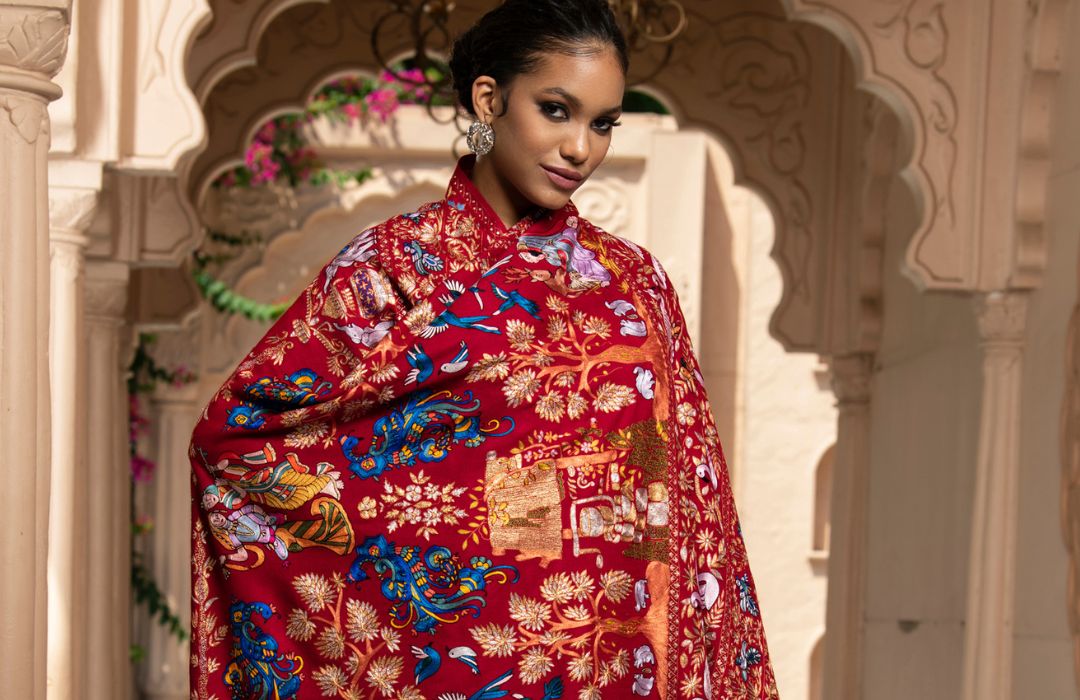
Gracing a touch of glamour to your bridal attire, Lilith is a handcrafted Pashmina shawl laden with embroidery
Tilla embroidery introduces metallic threads, dipped in real gold or silver, into the Cashmere fabric. This type of embroidery lends a regal and opulent touch to the shawl. Tilla work can be used to create elaborate designs, often featuring motifs inspired by Mughal and Persian art. The shimmering effect of the metallic threads contrasts beautifully with the softness of the Pashmina, making it a popular choice for bridal and formal wear.
Papier Mache Embroidery
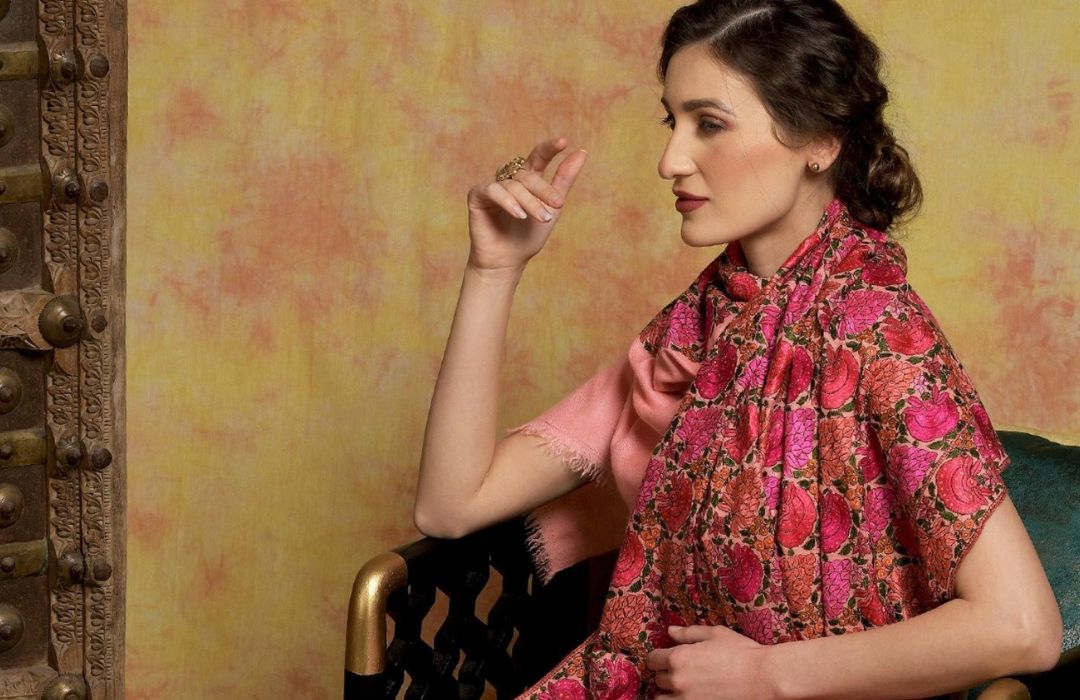
Papier Mache embroidery is a distinctive and less common form of embellishment on Pashmina shawls. This technique involves creating protruding and colourful patterns by using different threads that are thicker. The raised patterns are often floral, abstract, or geometric in nature. The resulting effect is a three-dimensional, textured surface that adds a unique and artistic element to the shawl.
Process of Producing Pashmina
Pashmina production is a highly intricate and labour-intensive process that involves the transformation of fine, delicate fibres into luxurious shawls. These have become synonymous with elegance and comfort. The journey of Pashmina from raw material to the finished product is a testament to the remarkable craftsmanship and dedication of skilled artisans. Let's delve into the fascinating world of Pashmina production.
Raw Material Collection
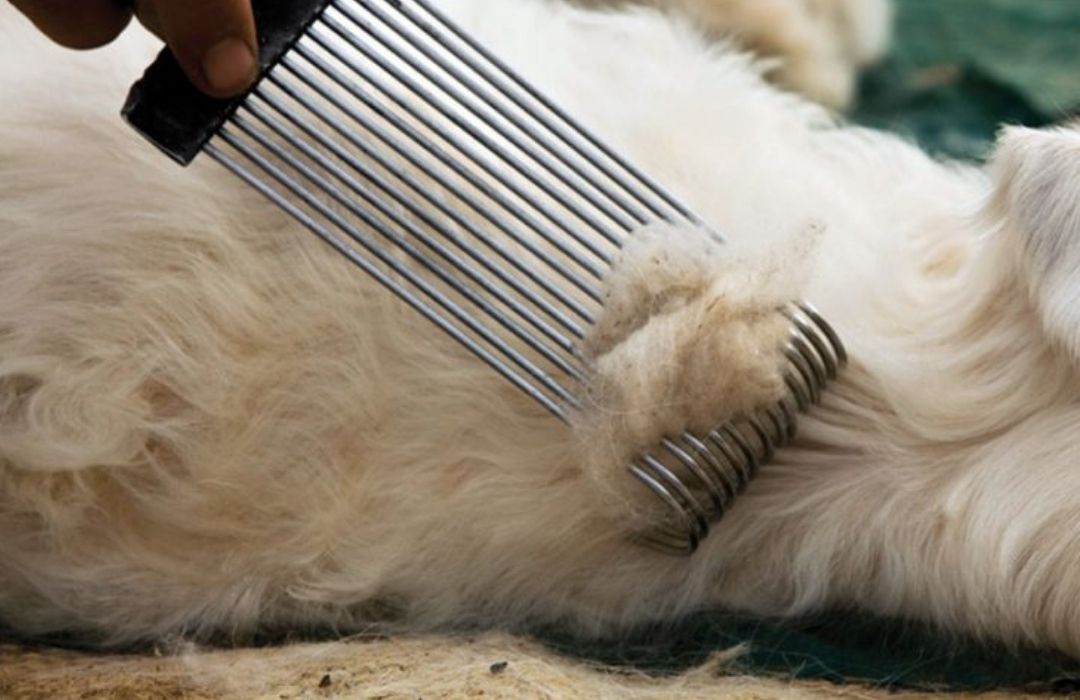
The process begins high in the Himalayan region, where herders collect the soft underbelly wool of the Capra hircus goat. This special breed of goat, also known as the Changthangi or Pashmina goat, survives the harsh climates of the region, developing an incredibly fine, soft, and insulating wool. Collecting this raw material is a laborious task, as it requires patience and expertise to obtain the wool without damaging it. Luckily the goat itself sheds this wool in the Spring season, when the same becomes uncomfortable for the animal. Herders hence find the wool scattered at several places and collect it. Professionals comb out the rest of the wool gently from the goat's body to send it for cleaning.
Sorting and Cleaning
Once collected, the raw Cashmere wool undergoes an extensive sorting and cleaning process. Skilled workers meticulously separate the fine underbelly fibres from the coarser outer layers. Hence they ensure that only the softest, finest fibers are used in the production. This separation process is crucial as it determines the quality and softness of the final product. It is the womenfolk who take the responsibility of cleaning and sorting Cashmere fibre. These women have decades of experience doing the same.
Spinning
Spinners then spin the cleaned fibres by hand, using traditional wooden spinning wheels. This manual spinning process ensures that the fibres are not stretched or damaged, hence preserving their natural softness and warmth. It is the womenfolk again, who are responsible for spinning the lumps of wool to fine fibres. With the perfect coordination between the spinning wheel and their hands, women transform raw hair into fibres which are just 12 - 15 microns in thickness.
Hand Weaving
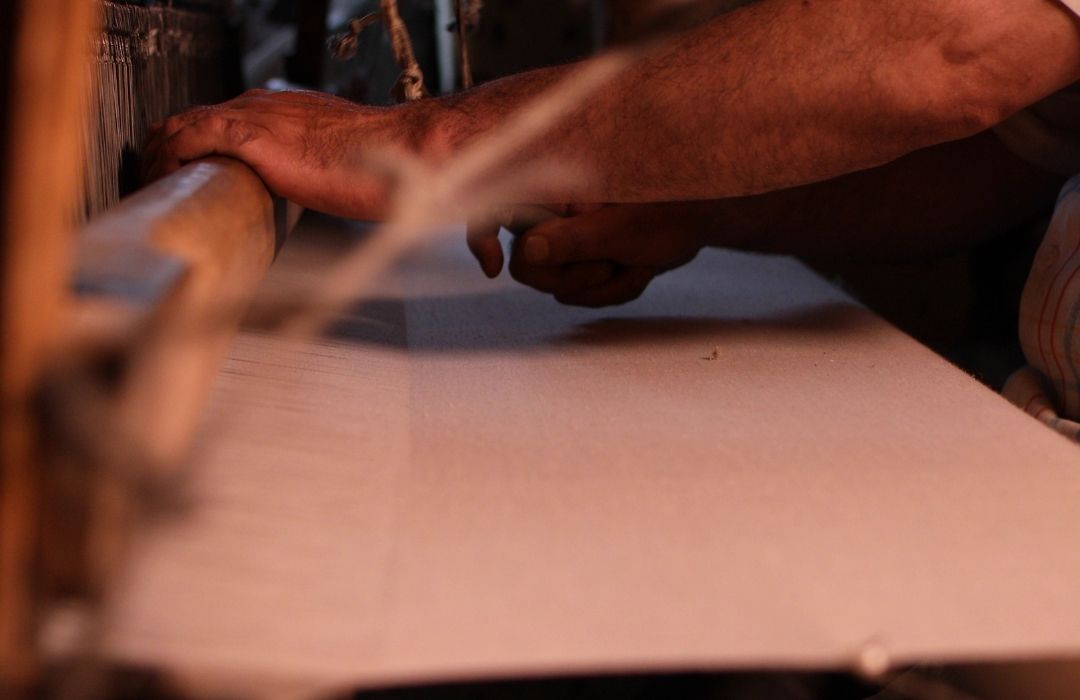
The heart of Pashmina production lies in the intricate weaving process. Skilled artisans use traditional wooden looms to weave the Cashmere threads into beautiful shawls. This process can be quite time-consuming, especially for shawls with intricate patterns like Kani or Jamawar. The dedication and precision of these artisans are instrumental in creating unique and high-quality products. Highly skilled artisans take 3 to 4 days to weave a solid Pashmina shawl and over 4 years to weave a Kani Jamawar.
Finishing and Embellishments
After the weaving is complete, Pashmina shawls undergo finishing touches. This can include adding embroidery like Tilla work, Sozni or papier mache designs. Simpler designs include prints, patterns, ombre dyeing or Swarovski studding. These artistic additions enhance the shawl's beauty and individuality.
Also read: THE CULTURAL HERITAGE OF PASHMINA
Pashmina - During and Post Wedding
The allure of Pashmina in bridal fashion is undeniable, and it adds a layer of elegance, sophistication, and warmth to a bride's ensemble. The use of Pashmina shawls and drapes in weddings is a tradition that has not only stood the test of time but has also evolved to embrace modern bridal aesthetics. But these aren't confined to just wedding days, but beyond. So, let's explore how Pashmina shawls are incorporated into bridal fashion, both during the wedding and in the post-wedding phase.
During the Wedding
- Wedding Favours: Hosts can create special memories by showering their guests with love with Pashmina shawls. These offer a touch of luxury and practicality to guests. These soft and beautifully crafted shawls not only keep guests warm during the celebration but also serve as lasting mementoes of the special day. Personalized with the names of the bride and groom or the wedding date, they add a personalized touch to the event itself
- Bridesmaid Shawls: Pashmina shawls are a beautiful choice as bridesmaid shawls at weddings. These luxurious shawls add an elegant touch to the bridesmaids' attire while providing warmth and comfort. Whether draped over the shoulders or elegantly folded, Pashmina shawls complement the bridesmaids' dresses, creating a coordinated and sophisticated look. They offer versatility by keeping the bridesmaids cozy during outdoor or winter ceremonies, all while adding a touch of opulence to the overall bridal party ensemble. Pashmina shawls also make thoughtful bridesmaid gifts, allowing them to cherish not only the memories of the special day but also the warmth and elegance of the shawls
Post-Wedding
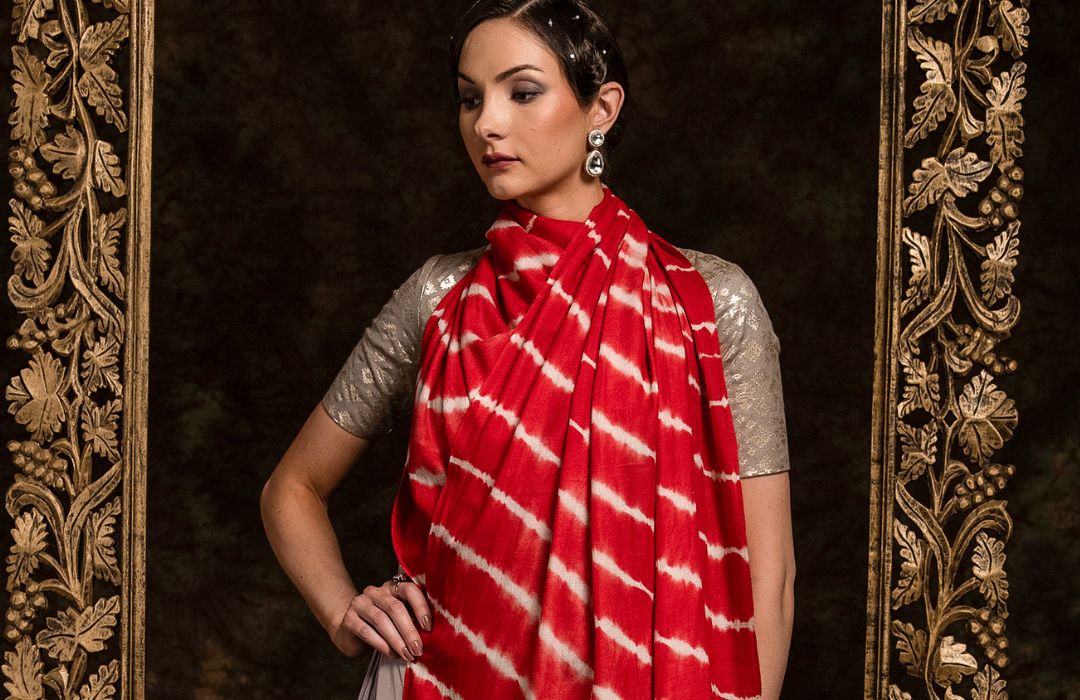
- Versatile Solid or Patterned Pashmina Shawls: While heavily embellished or intricately embroidered Pashmina shawls are perfect for the grandeur of the wedding ceremony, solids, patterns or Swarovski studded pieces are versatile and can be worn on various occasions post-wedding. These simpler styles are suitable for casual events, dinners, or gatherings, allowing the bride to carry a piece of her wedding elegance into everyday life.
- Pashmina Scarves for Honeymoons and Holidays: Pashmina scarves, with their lightweight yet warm nature, make excellent travel companions for honeymoons or holidays. Whether exploring a charming European city or lounging on a tropical beach, a Pashmina scarf can keep the bride comfortable in various weather conditions. Its versatility means it can be draped over the shoulders as a shawl or worn as a scarf, adapting to the climate and style of the destination.
Pashmina the Groom
- Gift for the Groom: The elegance and warmth of Pashmina are not for brides alone. Grooms can also appreciate the luxurious touch of a Pashmina shawl or scarf. This can be a thoughtful gift from the bride or a symbol of their union, mirroring the bride's own Pashmina, and adding a touch of coordination to their attire.
- Pashmina Baby Blankets: When a couple is blessed with a child, perhaps nothing is as cosy as a Pashmina blanket for the infinitely sensitive baby's skin. These exquisite blankets, crafted from the finest Pashmina wool, bring a touch of opulence to a baby's world. What sets Pashmina baby blankets apart is the extraordinary softness and warmth they offer, making them ideal for swaddling newborns or wrapping infants snugly. Pashmina's lightweight and breathable properties ensure that babies remain at the right temperature, whether in the crib or while being carried in a stroller. The natural breathability of Pashmina helps prevent overheating, keeping infants comfortable and content
Finding High-Quality Pashmina
When it comes to finding quality Pashmina for your bridal ensemble, authenticity and craftsmanship are of paramount importance. Here are some key factors to keep in mind when searching for the perfect bridal Pashmina:
Authentic Source
Ensure that you purchase your Pashmina from a reputable and authentic source. The finest Pashmina originates from the Kashmir region, so it's a good idea to look for sellers who can verify the origin of the shawls. Be cautious of mass-produced, imitation Pashmina shawls, as they often lack the quality and artistry of authentic Pashmina.
Purity of Pashmina
The purity of the Cashmere fibre is crucial. Authentic Pashmina is made from the wool of the Changthangi goat and is known for its exceptional softness and warmth. When shopping for bridal Pashmina, inquire about the purity and grade of the Pashmina used in the shawl. High-quality Pashmina will typically have a 100% purity of Cashmere wool. Fake shawls like Cashmere silk combinations or sheep wool shawls have flooded markets. Hence it is necessary to look for pure pieces.
Craftsmanship
The craftsmanship that goes into creating a Pashmina shawl is what sets it apart. Look for handwoven shawls, which often exhibit intricate patterns and detailing. Hand embroidery and embellishments, such as Sozni, Tilla, or Papier Mache's work, add a touch of artistry to the shawl, making it a work of wearable art. There are sellers who sell machine-made shawls which are even embroidered with machines. Even though these shawls look pretty, but do not stand anywhere when compared to pure shawls.
Feel and Texture
When selecting a bridal Pashmina, pay close attention to the feel and texture. Authentic Pashmina is incredibly soft, almost velvety to the touch, and it drapes beautifully. The genuine material is lightweight yet warm, offering comfort and grace to the bride.
Verify Authenticity
Ask for certification or documentation that authenticates the Pashmina's origin and quality. Reliable sellers often provide these details to assure buyers of the authenticity and quality of their products.
Customization
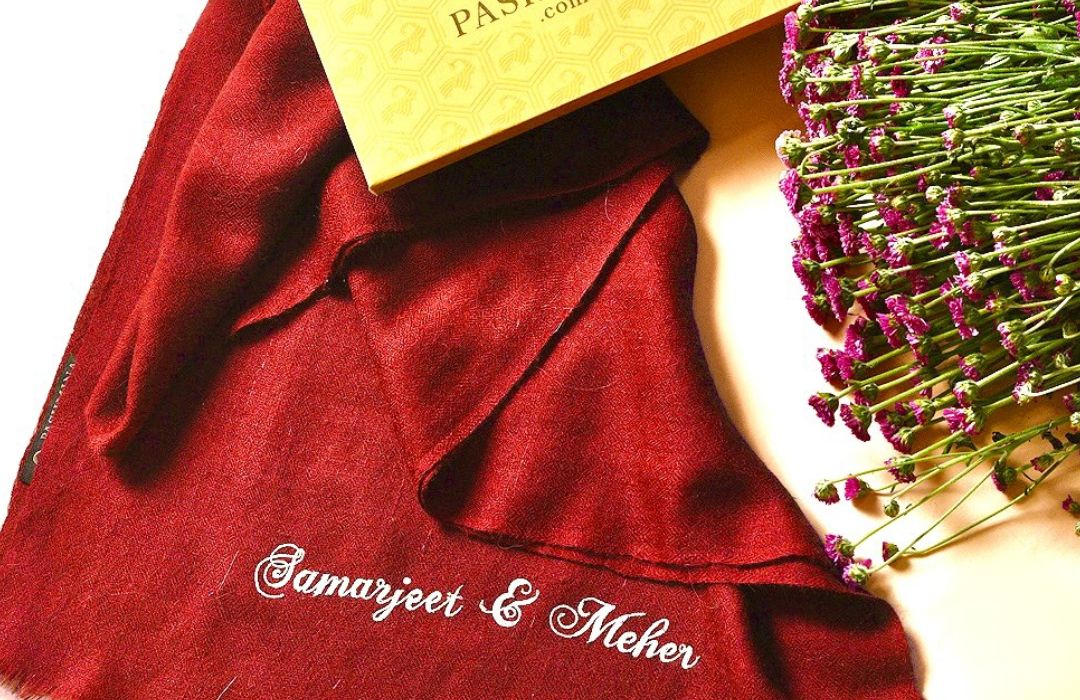
Some Pashmina sellers offer customization options, allowing you to choose specific colours, designs, or even personalized embroidery. This adds a unique and sentimental touch to your bridal Pashmina, making it even more special for your big day.
Price vs. Quality
While quality Pashmina may come at a higher price, it's an investment worth considering for a bridal accessory that not only complements your attire but can also be a cherished keepsake. Be cautious of deals that seem too good to be true, as they may indicate lower-quality or fake Pashmina.
Also read: PASHMINA AND MINIMALISM
Concluding
In the realm of bridal fashion, Pashmina emerges as an embodiment of heritage, craftsmanship, and timeless elegance. As we've explored the role of Pashmina in this journey, it's evident that these luxurious shawls are not just accessories; they are symbols of tradition, warmth, and artistic mastery.
Pashmina's journey begins with the purity of its wool, originating from the Himalayan region, where it is painstakingly collected, cleaned, and spun. The dedication of artisans is showcased in the intricate patterns, whether through Sozni, Tilla, or Papier Mache embroidery, adding depth to the fabric's beauty.
These shawls find their place in the bridal ensemble, draped over the shoulders or even as veils, bringing a touch of luxury and comfort to the special day. But their significance doesn't end there. Post-wedding, versatile Pashmina styles continue to provide warmth and elegance in everyday life and travel. As gifts for grooms or wedding favours, they encapsulate the warmth of love and appreciation.
Yet, perhaps the most crucial aspect is the authenticity of the Pashmina. Genuine Pashmina shawls exhibit a softness and warmth that is unparalleled, adding a layer of ethereal beauty to the bride's attire. Conversely, fake Pashmina can mar the experience, falling short of genuine excellence.
In conclusion, Pashmina shawls are not merely pieces of clothing; they are threads of tradition, art, and love. They make brides feel special and celebrated on their big day while offering a touch of opulence that lives on long after the wedding. In the grand tapestry of bridal fashion, Pashmina weaves a story of elegance and warmth that remains eternally captivating.
Also read: A JOURNEY TO THE SOURCE: VISITING PASHMINA-PRODUCING REGIONS